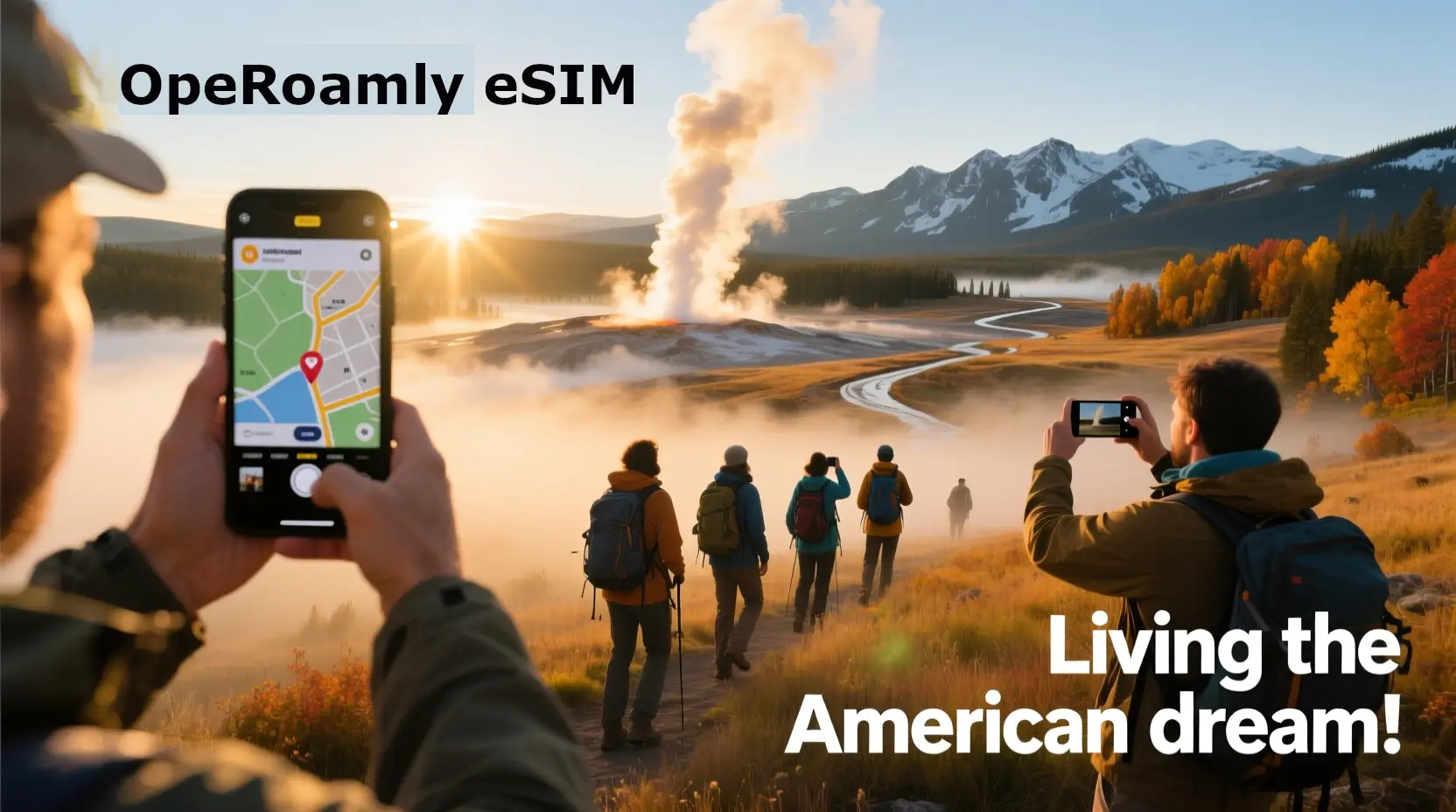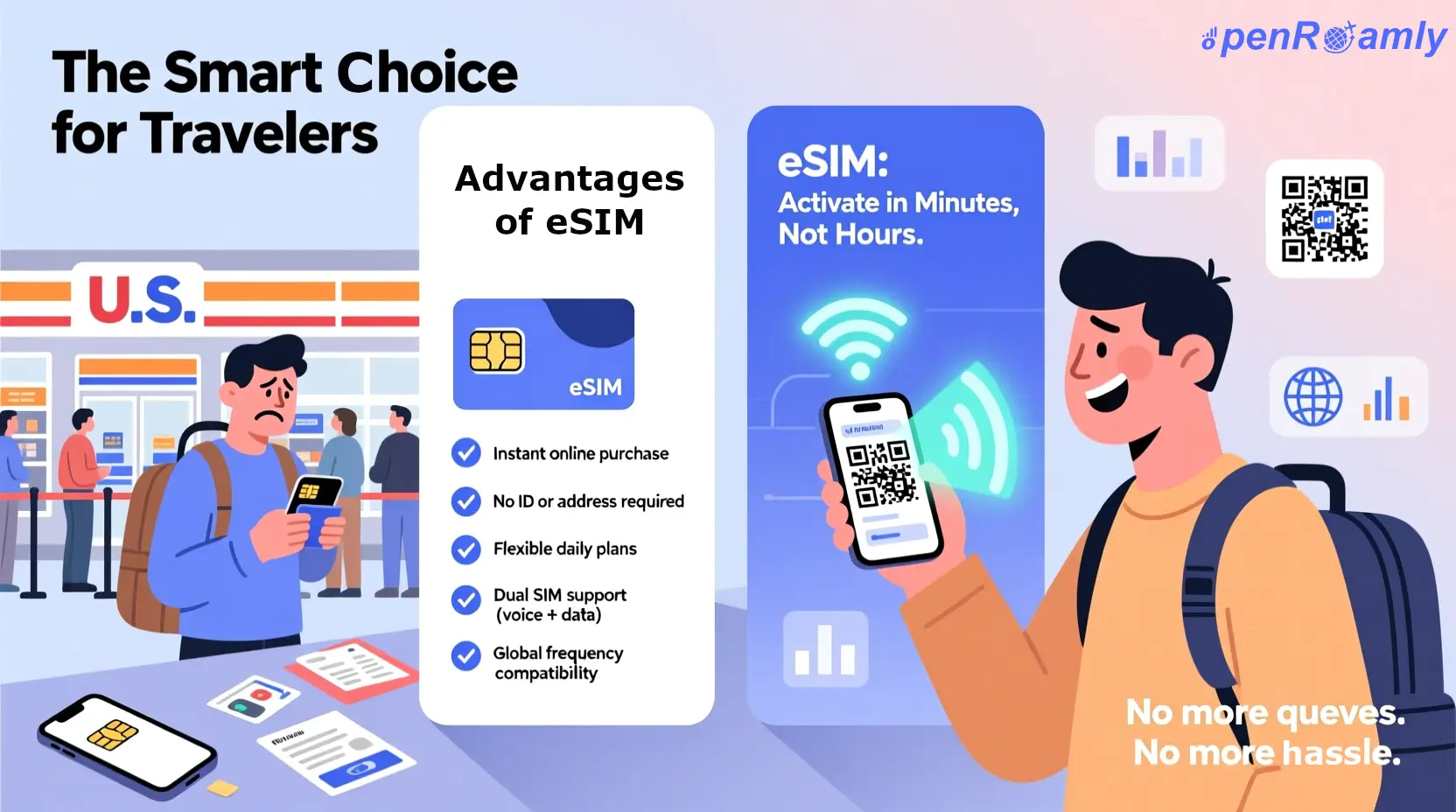Your Essential Guide to Internet in the USA: From Coverage to eSIM Choices

Planning an unforgettable journey to the United States? Whether you're exploring the vibrant streets of New York, marveling at the majestic national parks, or visiting loved ones, a reliable internet connection is no longer a luxury but a necessity. It’s crucial for navigation, staying in touch, sharing your experiences, and accessing vital information. This comprehensive guide will help you navigate your options for staying connected in the USA, ensuring a smooth and worry-free travel experience, especially with the rising popularity of eSIMs.

Understanding Network Coverage in the United States
The U.S. boasts a highly developed mobile communication infrastructure, primarily dominated by three major carriers: Verizon, AT&T, and T-Mobile. These providers generally offer extensive 4G LTE coverage nationwide and are actively expanding their 5G networks.
For travelers, expect robust and fast mobile internet service in major cities, along interstate highways, and at popular tourist destinations (such as national park visitor centers and main viewpoints). Verizon and AT&T often have a slight edge in coverage breadth, particularly in some less populated and rural areas. However, as you venture into the heart of national parks, mountainous regions, or deserts, signal strength can diminish significantly or disappear entirely. Therefore, it's wise to research the specific network conditions of your intended destinations and prepare for potential offline scenarios.
Free Wi-Fi: Availability and Limitations Across the USA
The good news for travelers is that free Wi-Fi is quite prevalent throughout the United States. Most major airports (like New York JFK, Los Angeles LAX, Chicago ORD) offer unlimited free Wi-Fi services. Similarly, from budget-friendly hotel chains to upscale resorts, the majority of accommodations include complimentary Wi-Fi. Additionally, coffee shops, fast-food restaurants, and many public libraries are excellent spots to find free internet access.
However, relying solely on free public Wi-Fi comes with several limitations:
Speed and Stability: Public Wi-Fi networks can often be slow or unstable due to high user traffic, making them unsuitable for video calls, large downloads, or real-time navigation.
Security Risks: Public networks are inherently less secure. Exercise extreme caution when performing banking transactions or entering sensitive personal information. Consider using a VPN for added security.
Inconvenience: Connecting to a new public Wi-Fi network often involves opening a browser, accepting terms and conditions, or watching advertisements, which can be cumbersome and interrupt your seamless mobile experience.
While free Wi-Fi serves as a valuable supplement, having your own dedicated mobile data plan ensures a more reliable, private, and consistently connected experience during your travels.
Smart Tips for Efficient Mobile Data Usage
To maximize your data plan's value and avoid unexpected overage charges, consider these practical recommendations:
Prepare Offline Content: Before your trip, or while connected to reliable Wi-Fi, download offline maps (like Google Maps), translation apps, travel guides, and any entertainment content (music, movies) you plan to use.
Manage Background Apps: In your phone's settings, disable background app refresh and automatic updates for non-essential applications. This can significantly reduce passive data consumption.
Utilize Data Saver Modes: Activate your phone's "Low Data Mode" or "Data Saver" feature. Your device will automatically restrict background data usage and optimize app data requests.
Prioritize Wi-Fi: Whenever available (e.g., at your hotel, airport, or a cafe), remember to switch to Wi-Fi to conserve your valuable mobile data.
Monitor Usage: Regularly check your data usage through your phone settings or your eSIM provider's app to stay within your plan limits.
Physical SIM Cards vs. eSIMs: The Smart Choice for Travelers

Upon arriving in the U.S., you might consider purchasing a physical SIM card from a local convenience store or carrier outlet. While technically feasible, this often presents several inconveniences for tourists:
Time-Consuming Process: You might need to provide identification, proof of address, and spend time queuing to complete the purchase and activation.
Less Flexible Plans: Prepaid plans designed for local residents often come with longer commitment periods (e.g., 30 days minimum), which might not be cost-effective for shorter trips.
Device Compatibility: You need to ensure your phone supports the U.S. carrier frequencies and has an available physical SIM card slot.
In contrast, an eSIM (embedded SIM card) offers a superior solution for international travelers:
Ultimate Convenience: Purchase your eSIM plan online before you even depart. Activation is typically done in minutes by scanning a QR code, meaning you're connected the moment you land, without needing to find a store or swap physical cards.
Transparent Pricing: eSIM plans are often designed specifically for travelers, offering clear daily or data-volume-based pricing, helping you avoid hidden fees associated with traditional roaming or local SIMs. They are frequently more cost-effective than international roaming and often cheaper than local physical SIM cards.
Dual SIM Benefits: If you need to keep your original phone number active for calls or SMS, an eSIM allows you to use both numbers simultaneously without removing your physical SIM card. One number can be for calls/SMS, and the other for data.
Instant Activation: Say goodbye to long queues and paper forms. eSIMs provide instant digital delivery and activation.
Choosing an eSIM simplifies your connectivity needs, saving you time, money, and hassle.
How to Select Your Ideal USA Data Plan
Choosing the right data plan is key to a stress-free travel experience. Evaluate your actual needs based on your usage habits, trip duration, and budget. Here are some recommendations based on different traveler profiles:
The Light User (Short Stays/Business/Transit):
Usage: Primarily for essential communication (emails, messaging apps), occasional map checks, and emergency browsing.
Recommendation: Look for small data bundles, such as plans offering 1-3 GB for 3-7 days. These are cost-effective and sufficient for basic needs.
The Standard Tourist (7-10 Day City Exploration):
Usage: Frequent map navigation, regular social media updates, searching for restaurants, occasional video streaming, and messaging.
Recommendation: A mid-range plan providing 5-10 GB for 7-14 days should comfortably cover daily requirements for a typical city trip.
The Heavy User (Long Road Trips/Frequent Navigation/Content Creators):
Usage: Extensive use of real-time navigation, uploading numerous photos/videos, frequent video calls, online streaming, and constant connectivity.
Recommendation: Opt for larger data packages, such as 15-30 GB for 15-30 days. This ensures a worry-free connection for extended and data-intensive travel.
The Wi-Fi Dependent Traveler (Emergency Use Only):
Usage: Relies heavily on free Wi-Fi and only needs mobile data for emergencies or short bursts when Wi-Fi isn't available.
Recommendation: Consider daily data bundles (e.g., 500 MB - 1 GB per day), activated only on days you need it, or a small total data package (e.g., 1-2 GB total) valid for your trip duration.
The Unlimited Data Seeker (Live Streaming/Heavy Video Consumption):
Usage: Needs constant, high-volume data for live streaming, extensive video conferencing, gaming, or watching a lot of online video content.
Recommendation: An unlimited data plan (check for fair usage policies) is your best bet to ensure you never run out of data, allowing complete freedom of use.
Conclusion
A reliable and economical internet connection can significantly enhance your trip to the United States. Understanding the local network environment, making smart use of free Wi-Fi, and selecting an appropriate data plan based on your needs are crucial steps in your pre-trip preparations. The emergence of eSIM technology offers global travelers an unprecedentedly convenient and efficient option for staying connected. Plan ahead, travel light, and enjoy your American adventure!
For a wide range of USA eSIM plans tailored to various travel needs, you can explore options at OpenRoamly United States. Ensure you choose the perfect plan to make your journey seamless and connected.